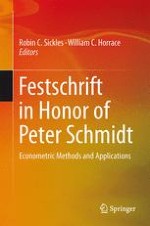2014 | OriginalPaper | Buchkapitel
9. Modelling Asymmetric Cointegration and Dynamic Multipliers in a Nonlinear ARDL Framework
verfasst von : Yongcheol Shin, Byungchul Yu, Matthew Greenwood-Nimmo
Erschienen in: Festschrift in Honor of Peter Schmidt
Verlag: Springer New York
Aktivieren Sie unsere intelligente Suche, um passende Fachinhalte oder Patente zu finden.
Wählen Sie Textabschnitte aus um mit Künstlicher Intelligenz passenden Patente zu finden. powered by
Markieren Sie Textabschnitte, um KI-gestützt weitere passende Inhalte zu finden. powered by
